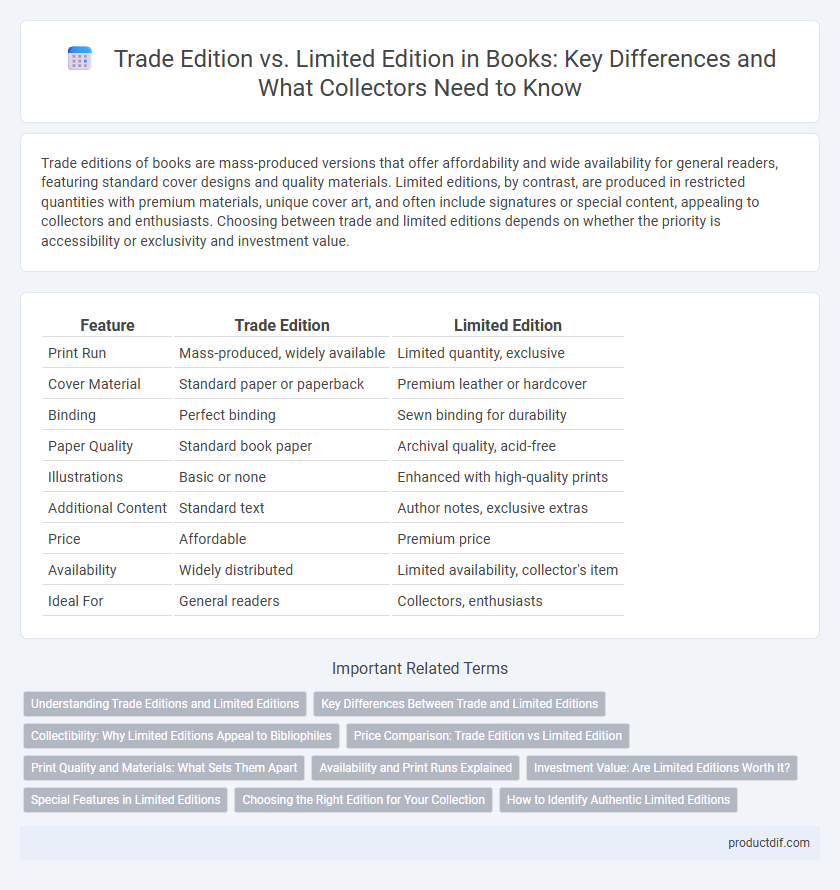Trade editions of books are mass-produced versions that offer affordability and wide availability for general readers, featuring standard cover designs and quality materials. Limited editions, by contrast, are produced in restricted quantities with premium materials, unique cover art, and often include signatures or special content, appealing to collectors and enthusiasts. Choosing between trade and limited editions depends on whether the priority is accessibility or exclusivity and investment value.
Table of Comparison
| Feature | Trade Edition | Limited Edition |
|---|---|---|
| Print Run | Mass-produced, widely available | Limited quantity, exclusive |
| Cover Material | Standard paper or paperback | Premium leather or hardcover |
| Binding | Perfect binding | Sewn binding for durability |
| Paper Quality | Standard book paper | Archival quality, acid-free |
| Illustrations | Basic or none | Enhanced with high-quality prints |
| Additional Content | Standard text | Author notes, exclusive extras |
| Price | Affordable | Premium price |
| Availability | Widely distributed | Limited availability, collector's item |
| Ideal For | General readers | Collectors, enthusiasts |
Understanding Trade Editions and Limited Editions
Trade editions are mass-produced books widely available in bookstores and online, characterized by standard formatting and affordable pricing aimed at general readers. Limited editions are exclusive, often numbered or signed copies with unique features such as high-quality paper, special bindings, and collectible value, targeting collectors and enthusiasts. Understanding the distinction between trade and limited editions helps readers and collectors make informed decisions based on accessibility, aesthetics, and investment potential.
Key Differences Between Trade and Limited Editions
Trade editions are mass-produced, widely available books designed for general retail markets, typically printed on standard-quality paper with paperback or basic hardcover bindings. Limited editions feature exclusive content, higher-quality materials such as premium paper, superior bindings, and often include signed copies or unique numbering to enhance collectibility. The key differences lie in production volume, material quality, exclusivity, and target audience, with trade editions appealing to casual readers and limited editions catering to collectors and enthusiasts.
Collectibility: Why Limited Editions Appeal to Bibliophiles
Limited Editions attract bibliophiles due to their rarity and exclusivity, often featuring unique cover designs, numbered copies, and author signatures. These attributes enhance the book's value and desirability within collector communities, setting them apart from widely available Trade Editions. The scarcity and craftsmanship associated with Limited Editions create a tangible connection to the literary work, elevating their status as prized collectibles.
Price Comparison: Trade Edition vs Limited Edition
Trade editions are typically priced lower due to mass production and wider distribution, making them more accessible to general readers. Limited editions command higher prices reflecting their exclusivity, premium materials, and often include signed copies or special features. Collectors and enthusiasts are willing to pay a premium for limited editions because of their rarity and enhanced value.
Print Quality and Materials: What Sets Them Apart
Trade editions typically use standard-quality paper and cover materials designed for mass production, ensuring affordability and accessibility for general readers. Limited editions are distinguished by premium paper stock, often archival or acid-free, and high-end binding materials like leather or silk, enhancing durability and aesthetic appeal. These superior print quality and materials make limited editions highly sought after by collectors and bibliophiles.
Availability and Print Runs Explained
Trade editions are widely available and printed in large quantities to meet mass market demand, typically ranging from tens of thousands to hundreds of thousands of copies per print run. Limited editions feature restricted print runs, often numbered and ranging from a few hundred to a few thousand copies, enhancing their exclusivity and collector value. Availability of limited editions is scarce, often sold through specialty retailers or directly from publishers, making them highly sought after by collectors and enthusiasts.
Investment Value: Are Limited Editions Worth It?
Limited edition books often hold higher investment value due to their rarity, unique features such as special bindings or author signatures, and limited print runs, making them more sought-after by collectors. Trade editions, being mass-produced and widely available, generally have lower collectible worth and slower appreciation over time. Investing in limited editions can yield significant returns if the book gains cultural or literary significance, but market demand and condition remain crucial factors in valuation.
Special Features in Limited Editions
Limited Edition books often include special features such as exclusive cover art, numbered copies, and signed pages by the author, enhancing their collectible value. They may also contain unique content like bonus chapters, illustrations, or high-quality paper, distinguishing them from standard Trade Editions. These enhancements cater to collectors and enthusiasts seeking rarity and enhanced aesthetic appeal in their book collections.
Choosing the Right Edition for Your Collection
Trade edition books offer affordability and wide availability, making them perfect for casual readers seeking accessibility and variety. Limited edition books prioritize exclusivity and enhanced craftsmanship, featuring special bindings, signatures, or unique artwork ideal for serious collectors. Choosing the right edition depends on your budget, collection goals, and appreciation for rarity or mass-market appeal.
How to Identify Authentic Limited Editions
Authentic limited edition books can be identified by their unique features such as numbered copies, signatures from the author or illustrator, and specialized binding materials like leather or cloth. Trade editions usually lack these distinguishing markers and are produced in larger quantities with standard covers and paper quality. Checking the edition statement, publisher's notes, and verifying through reputable dealers or official sources ensures the authenticity of a limited edition book.
Trade Edition vs Limited Edition Infographic

 productdif.com
productdif.com